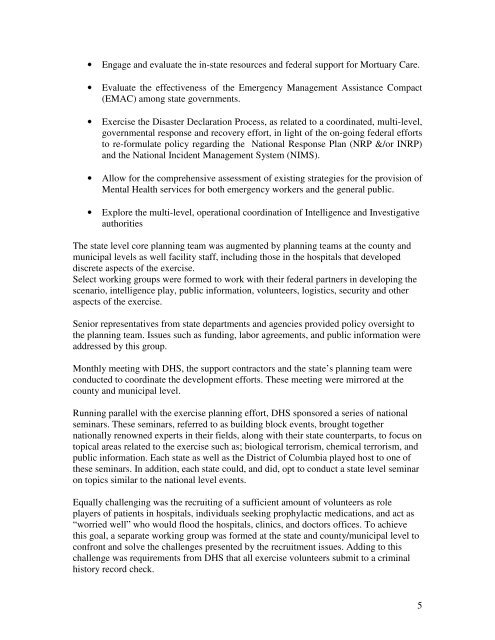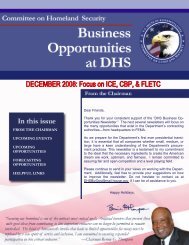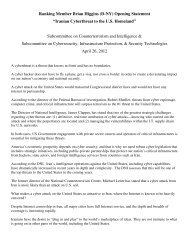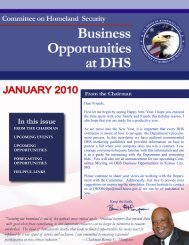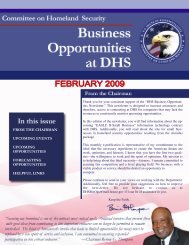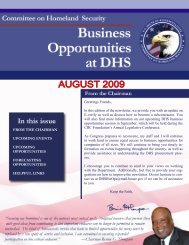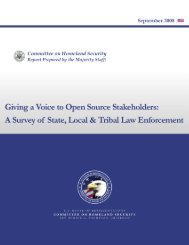Testimony - Langenbach - Committee on Homeland Security
Testimony - Langenbach - Committee on Homeland Security
Testimony - Langenbach - Committee on Homeland Security
Create successful ePaper yourself
Turn your PDF publications into a flip-book with our unique Google optimized e-Paper software.
• Engage and evaluate the in-state resources and federal support for Mortuary Care.• Evaluate the effectiveness of the Emergency Management Assistance Compact(EMAC) am<strong>on</strong>g state governments.• Exercise the Disaster Declarati<strong>on</strong> Process, as related to a coordinated, multi-level,governmental resp<strong>on</strong>se and recovery effort, in light of the <strong>on</strong>-going federal effortsto re-formulate policy regarding the Nati<strong>on</strong>al Resp<strong>on</strong>se Plan (NRP &/or INRP)and the Nati<strong>on</strong>al Incident Management System (NIMS).• Allow for the comprehensive assessment of existing strategies for the provisi<strong>on</strong> ofMental Health services for both emergency workers and the general public.• Explore the multi-level, operati<strong>on</strong>al coordinati<strong>on</strong> of Intelligence and InvestigativeauthoritiesThe state level core planning team was augmented by planning teams at the county andmunicipal levels as well facility staff, including those in the hospitals that developeddiscrete aspects of the exercise.Select working groups were formed to work with their federal partners in developing thescenario, intelligence play, public informati<strong>on</strong>, volunteers, logistics, security and otheraspects of the exercise.Senior representatives from state departments and agencies provided policy oversight tothe planning team. Issues such as funding, labor agreements, and public informati<strong>on</strong> wereaddressed by this group.M<strong>on</strong>thly meeting with DHS, the support c<strong>on</strong>tractors and the state’s planning team werec<strong>on</strong>ducted to coordinate the development efforts. These meeting were mirrored at thecounty and municipal level.Running parallel with the exercise planning effort, DHS sp<strong>on</strong>sored a series of nati<strong>on</strong>alseminars. These seminars, referred to as building block events, brought togethernati<strong>on</strong>ally renowned experts in their fields, al<strong>on</strong>g with their state counterparts, to focus <strong>on</strong>topical areas related to the exercise such as; biological terrorism, chemical terrorism, andpublic informati<strong>on</strong>. Each state as well as the District of Columbia played host to <strong>on</strong>e ofthese seminars. In additi<strong>on</strong>, each state could, and did, opt to c<strong>on</strong>duct a state level seminar<strong>on</strong> topics similar to the nati<strong>on</strong>al level events.Equally challenging was the recruiting of a sufficient amount of volunteers as roleplayers of patients in hospitals, individuals seeking prophylactic medicati<strong>on</strong>s, and act as“worried well” who would flood the hospitals, clinics, and doctors offices. To achievethis goal, a separate working group was formed at the state and county/municipal level toc<strong>on</strong>fr<strong>on</strong>t and solve the challenges presented by the recruitment issues. Adding to thischallenge was requirements from DHS that all exercise volunteers submit to a criminalhistory record check.5


